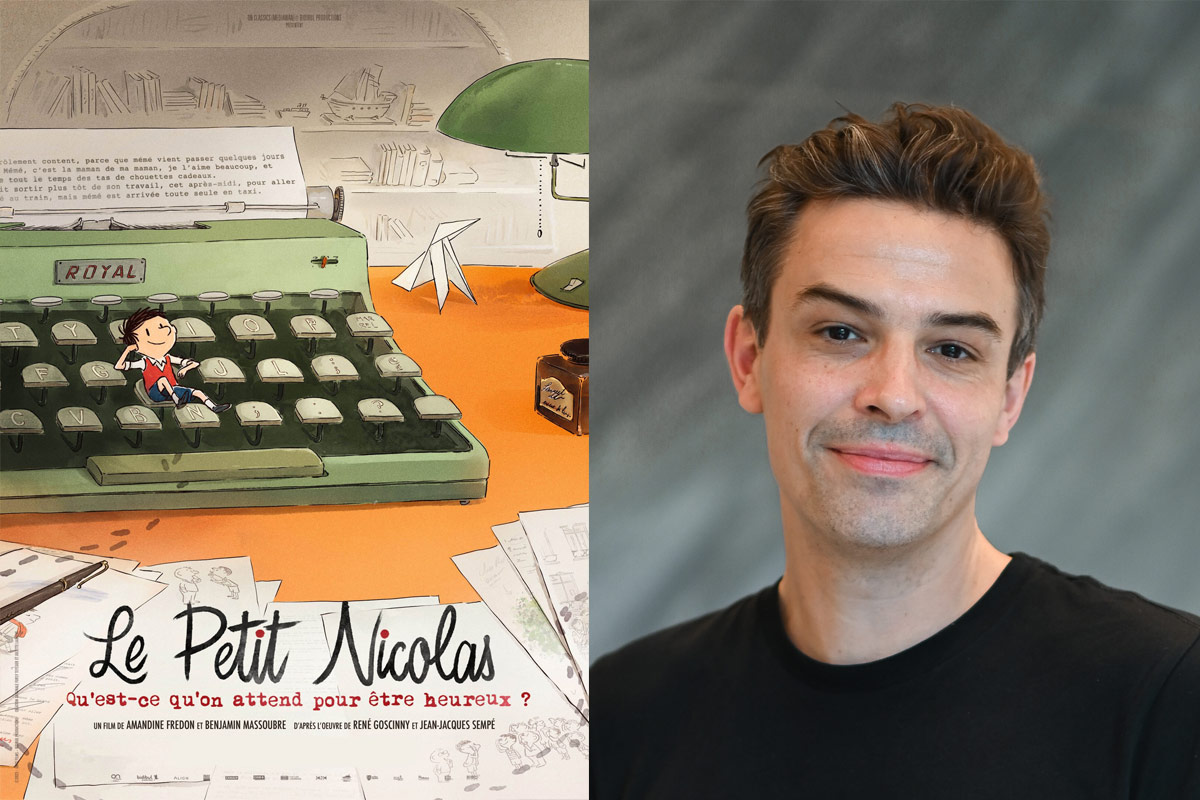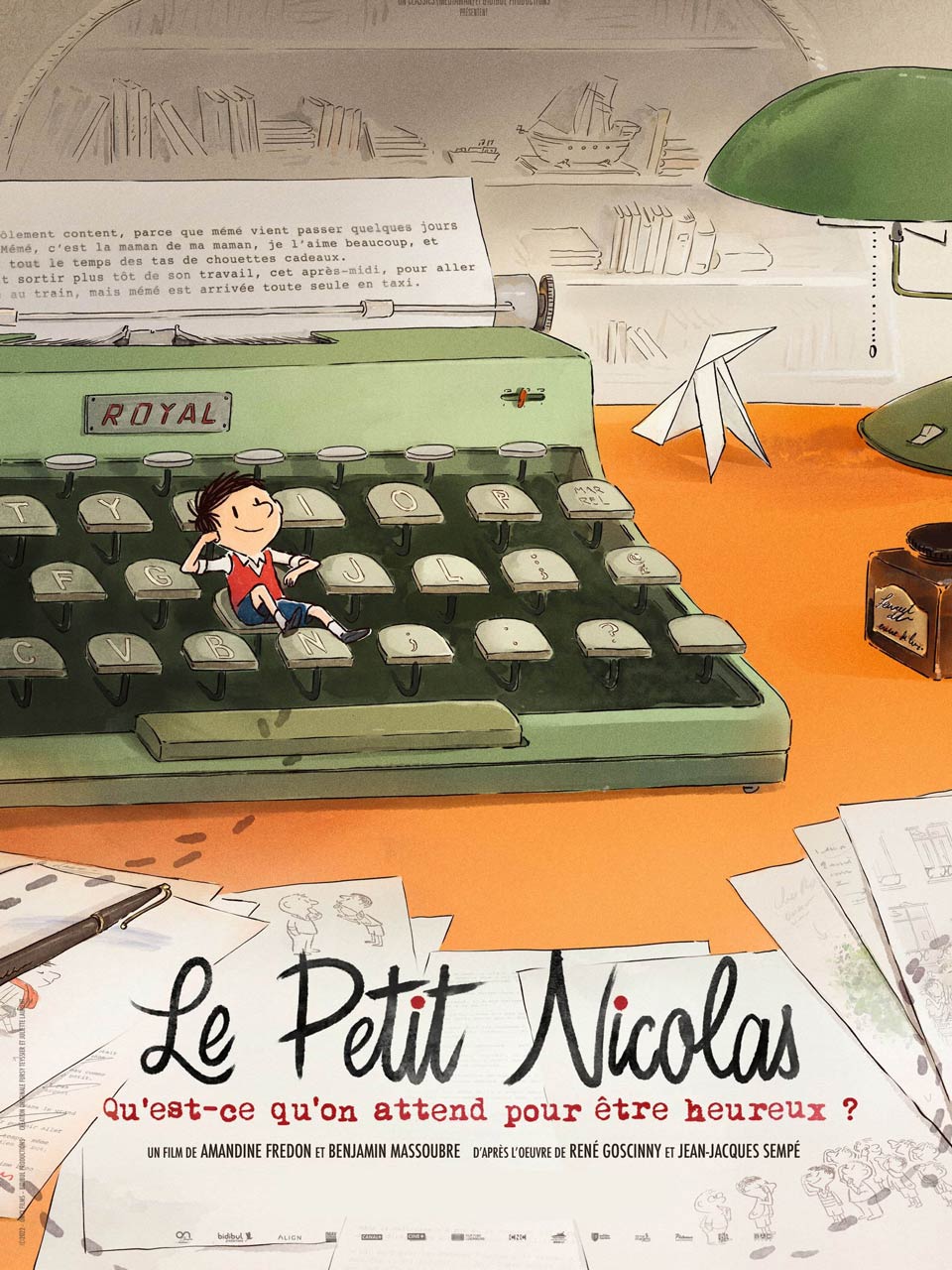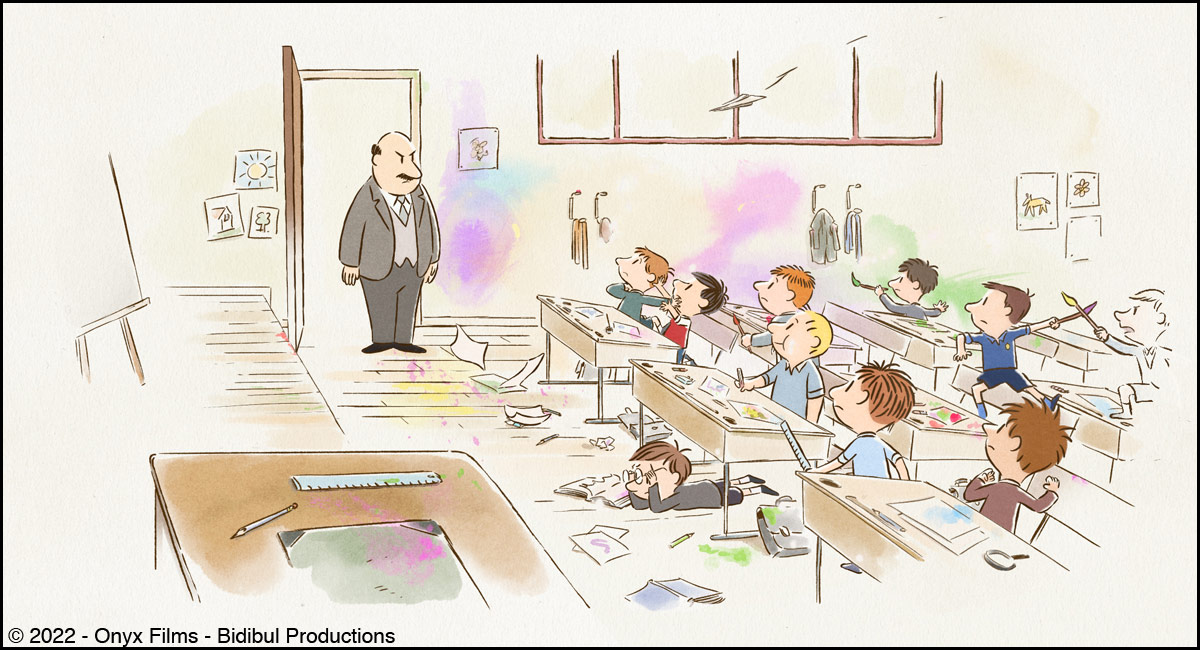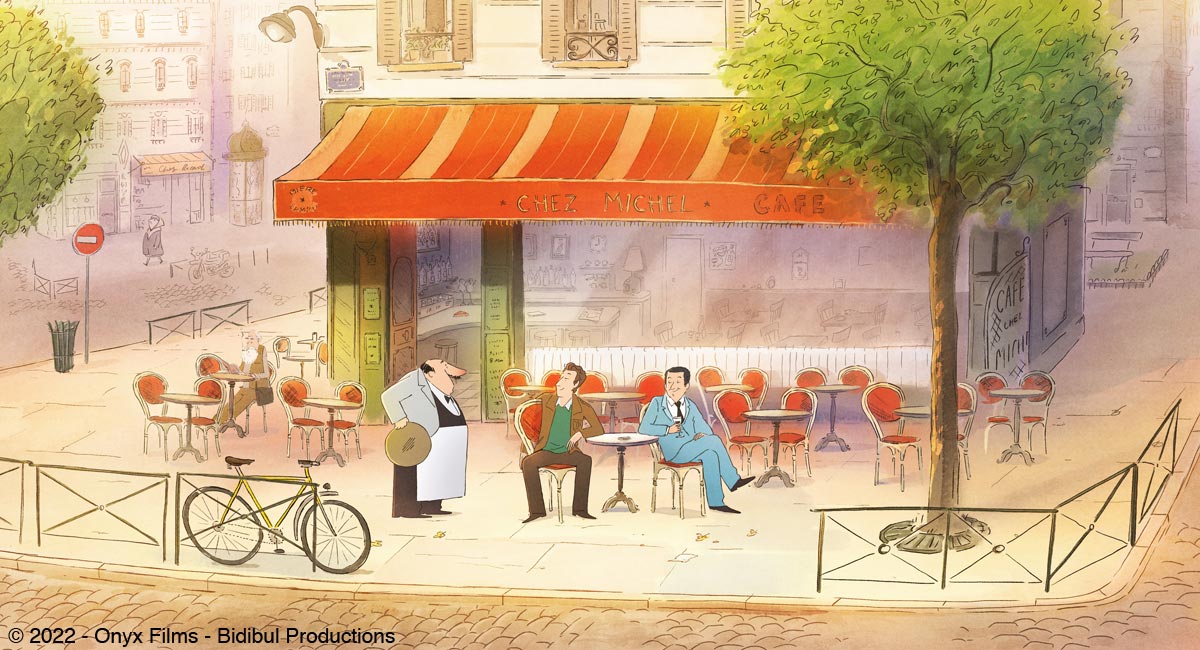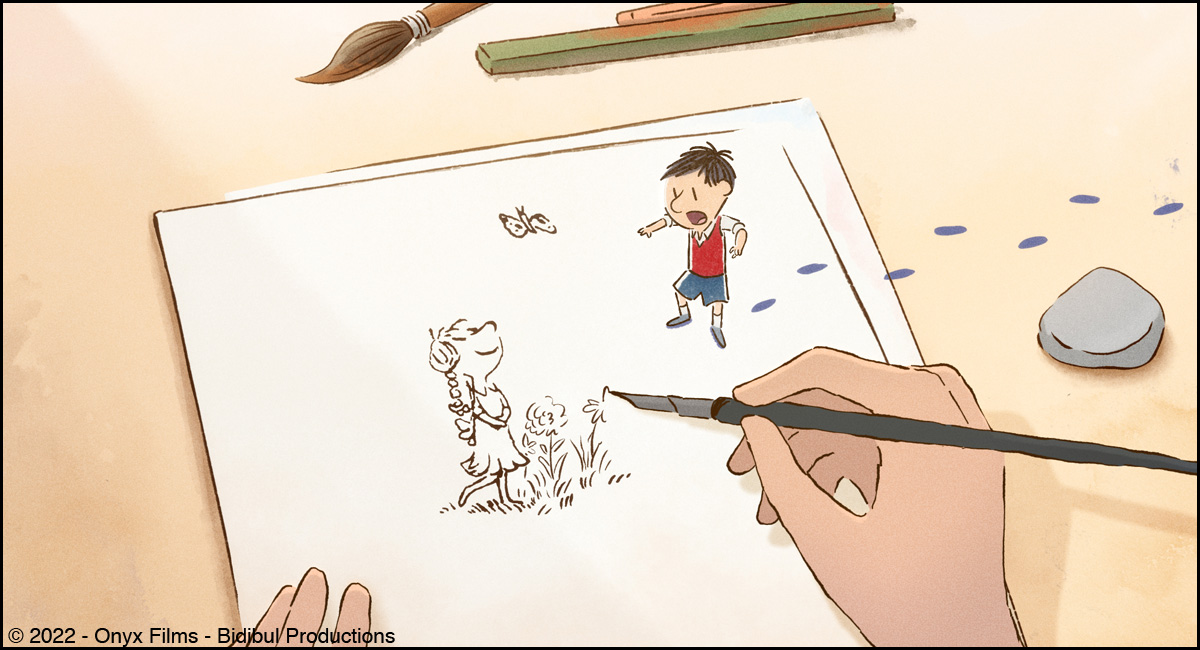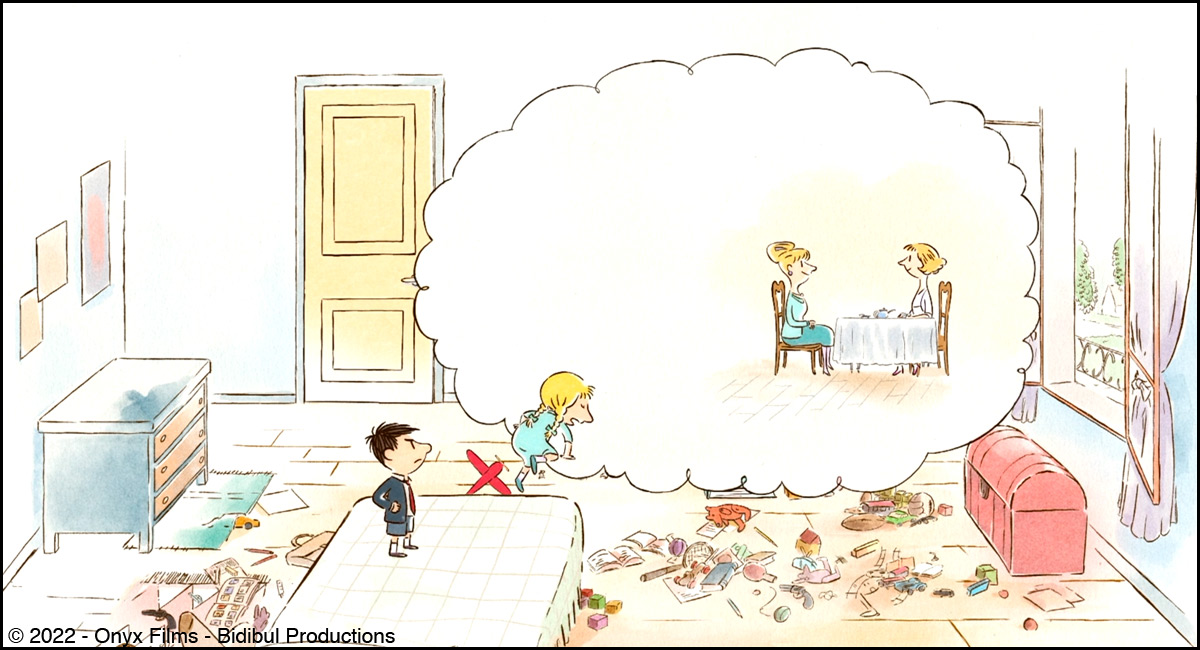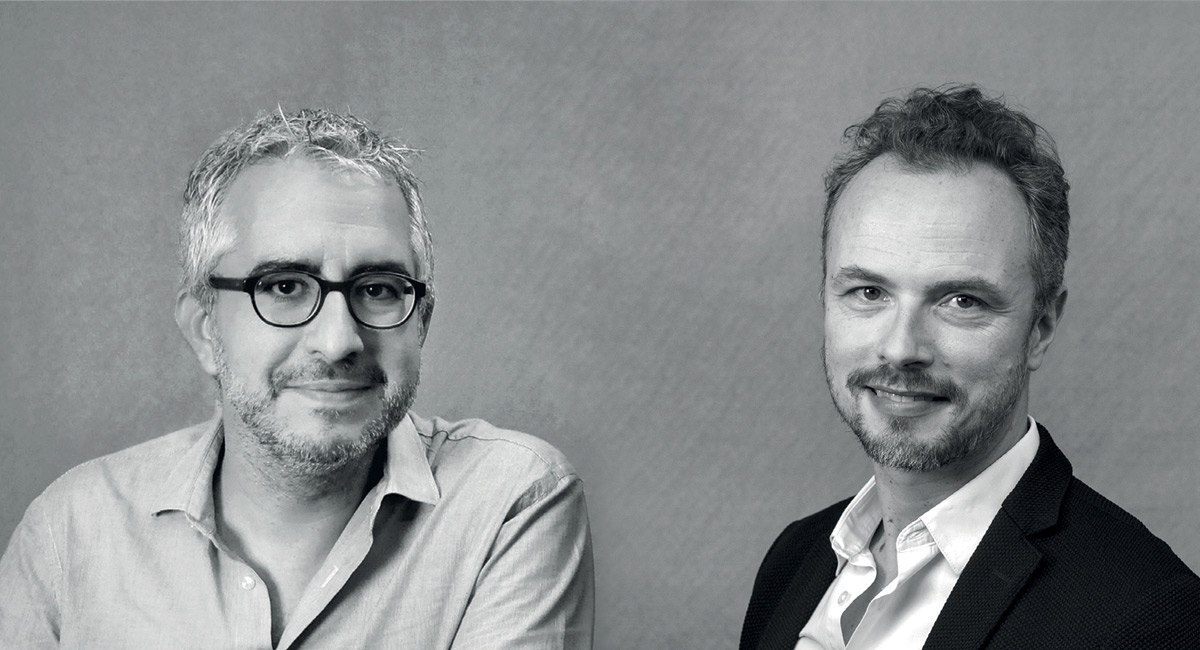Synopsis
Somewhere between Montmartre and Saint-Germain-des-Prés, Jean-Jacques Sempé and René Goscinny lean over a large white sheet of paper and bring to life a mischievous and endearing boy, Little Nicholas. From schoolyard games and fights to summer camp prank and camaraderie, Nicholas lives a merry and enriching childhood. As the adventures of Nicholas and his friends unfold, the boy makes his way into his creators’ workshop and light-heartedly questions them. Sempé and Goscinny will recount the story of their friendship, career, and reveal a childhood filled with hopes and dreams.
Film credits
Directors: Amandine Fredon and Benjamin Massoubre
Scriptwriters: Anne Goscinny, Benjamin Massoubre, and Michel Fessler (Based on Le Petit Nicolas by René Goscinny and Jean-Jacques Sempé)
Art Director: Fursy Teyssier
Music: Ludovic Bource
Producers: Aton Soumache, Lilian Eche, Cédric Pilot, Christel Henon, Adrian Politowski, Martin Metz, and Nadia Khamlichi
Production companies: On Classics (France), Bidibul Productions (Luxembourg), and Align Pictures (USA)
Technique: 2D digital, diverse techniques
Running time: 82 minutes
Little Nicholas – Happy as Can Be is a beautiful and charming film with a story for everyone: the true story behind the creation of the French comic classic “Little Nicholas”.
The film has a unique style of storytelling: nicely integrating the story of Nicholas, the fictional main character of the comic, and the biographies of two legendary French comic creators René Goscinny and Jean-Jacques Sempé, who brought Nicholas into being and raised him. The story is touching and gives insight on the creation of the eminent French comic creator’s characters and stories, depicted with delicate 2D animation.
The film got the Cristal for a Feature Film at Annecy Festival 2022, one of the most globally prestigious awards for animated feature films, soon after its world premiere at the Cannes Film Festival 2022 on 20th May.
We are very happy to share with you the insightful words from Benjamin Massoubre, one of the two co-directors of the film, about the story behind the film’s creation.
Interview with Benjamin Massoubre
Hideki Nagaishi (HN): How did the film project start? Did you join the film project from the beginning?
Benjamin Massoubre: No, I didn’t join the movie in its genesis. The project was initiated by Anne Goscinny and the producers 7 years ago. At first, it was supposed to mix archive footage of the creators and animation for the stories of the Little Nicholas, but due to the poor quality of the archive it was impossible. So, they decided to make a fully animated movie. Financing took quite a long time because of the audacity of the script that is both an homage to the Little Nicholas stories and a biopic of its creators René Goscinny and Jean-Jacques Sempé. I came on board 2 and a half years ago to give a hand to Amandine Fredon and I immediately began rewrites on the script with Anne before going to the storyboard and the editing room.
HN: What part of the comic Little Nicholas did you find the most attractive, and how did you reflect that into the film?
Benjamin Massoubre: Nicholas is the narrator of all the short stories: his adventures are told through a child’s point of view. I think that’s where all the comedy and poetry of Little Nicholas resides. It’s everyday life through the eyes of an 8 year old boy, with his laughs, his pains and moments of happiness. It still works today because kids can relate to Nicholas, even though it was written in the 50’s; kids all have parents, grandparents, and all go to school. They all want to cut school or to play tricks on their teachers. And the adults can relate to the poetry and the nostalgia of that childhood. That what’s so great with Goscinny’s writing: it speaks to everyone through generations from 7 to 77.
HN: What creative difficulties or challenges during the film project were memorable for you?
Benjamin Massoubre: There were two main difficulties: one was finding the good rhythm to tell that really atypical story, and the other was reproducing Jean-Jacques Sempé drawings.
On the narrative side, the movie is not built like a typical 3 or 4 act piece. It’s more built like a musical with members or a sketch comedy movie mixing sequences of the creators at work, flashbacks on their lives and short stories of Little Nicholas. My editing background came in handy to build that emotional arc the movie needed: that story of resilience of two guys that were robbed of their childhood, René because he lost part of his family during the Holocaust, and Jean-Jacques because he was abused by an alcoholic stepfather.
It is the story of two creators that built that perfect childhood for Little Nicholas to exorcise their own traumas. Two guys that made the conscious choice of not letting life bring them down through comedy and poetry.
On the artistic direction side, we studied Jean-Jacques’s work closely, and went into every detail. We had the chance to work closely with him in the pre-production stage. We created two worlds based on Jean-Jacques’s work: one of Nicholas based on the illustrations from the book, the other, the world of the creators based on Jean-Jacques’ more structured work, like what he did for the covers of the New Yorker.
HN: The original story of the comics, and the two creators’ biography, which focuses on things strongly related to the creation and development of the lively comic characters, are integrated into the film’s naturally-structured story. I would like to hear about how you neatly put the complex pieces of the storytelling puzzle into such a well-structured story. What creative process did you use to write the whole story, and what did you take care in the most?
Benjamin Massoubre: It was a lot of work, starting with rewrites I did with Anne Goscinny, continuing at the storyboard stage all through the editing process. Piece by piece, sequence by sequence, going back and forth on flashbacks and short stories, we built that atypical movie. In the end it was really about building empathy for the characters so we could convey some emotion to the audience when we learn about their ups and downs and René’s passing. Movies are all about feelings for me, and our work as directors is to put the audience in the character’s shoes so can they can feel what they feel, laugh when they laugh, cry when they do.
HN: The conversations among Nicholas and many classmates have an endearing sense of humour unique to children, born from their strong curiosity and pure hearts. How did you achieve writing such lively conversations?
Benjamin Massoubre: We stayed as true as possible to René’s writing. Most of the dialog between the children is extracted directly from the original short stories. It’s his style that makes Little Nicholas so special: we tried to pay tribute to that genius that has been making people laugh from the 50’s to our time.
HN: The film uses an elegant form of animation expression: the line drawings of characters and background art appear on a white background, as if Jean-Jacques Sempé were drawing a comic on white paper, which is then delicately coloured in with watercolour paint, and the characters spring to life. There are several wonderful scene transitions in the film such as having the background art spread to a new direction, as if it is being painted in front of the audience, and a new scene popping up like a speech balloon in a comic.
How did you come up with these visual expressions and what did you take care in the most when you created those visual style of expressions?
Benjamin Massoubre: We needed two different styles for the two different sides of our story, the “real world” of the creators and the “imaginary” world of Little Nicholas. Like I said, both are based on Jean-Jacques’s work: his early work for the short stories of Nicholas and his more accomplished work like what he did for the New Yorker for the parts of the creators. That way, we built two different artistic directions but also we used two different ways of framing and directing. In the world of the creators, we do cinema as usual: close ups, travelling shots, pans etc. In the world of Nicholas, we stick to a grammar of only wide shots, like the illustrations of the short stories, to make the audience feel like they’re diving into the books. And we had fun linking the two worlds, with watercolor animation, trick shots panning from one world to the other and still drawing coming to life.
HN: The music of the film enhances the audience’s ability to sympathize with the characters in each scene. Could you please let us know the story behind the music composition for the film?
Benjamin Massoubre: When I first began cutting the movie, I studied Jean-Jacques’s taste in music. He likes jazz: Django Rheinhart, Duke Ellington, and the melodies of the popular tunes of post-WWII France like Trenet, Ventura and Misraki. With the movie we wanted to convey that nostalgia of the France of the late 50’s that is stuck in the world’s popular culture. On foot in jazzy Saint Germain, the other in the pop culture of that time. Pretty early we felt that Ludovic Bource would be the perfect composer to convey that particular nostalgia and we were right: he was the final piece that made the movie all.



